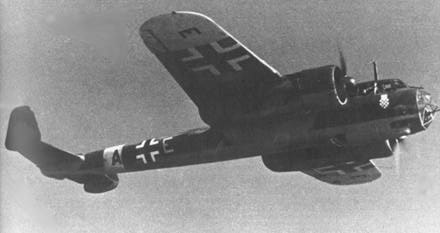|

|
The Dornier Do 17 was a German medium bomber, reconnaissance, and night-fighter aircraft. This Dornier design was known as the "Flying Pencil" or "Eversharp" because of its long, narrow fuselage. Originally developed as a commercial mail-carrying aircraft, the Do 17 was rejected for that role but was adopted by the Luftwaffe as a high-speed bomber in 1935. The first two production models - the Do17E and F - saw combat in the Spanish civil war as bombers. They were followed by specialized pathfinder and photo-reconnaissance variants, with bomber versions continuing to be improved. A night-fighter version was evaluated, being a Do 17Z-3 with the nose of a Ju 88 fighter, but that hybrid was abandoned for a specialized night-fighter configuration of the Do-17, of which only nine were completed. The planes were in the forefront of German assaults throughout Europe and in the Battle of Britain. By mid-1941 the Do 217 had replaced the earlier plane, with the improved Do 215 serving into 1942. Production of the Do 17 totaled some 1,700 aircraft. The Do 215 production run was smaller. The latter designation was derived from a Do 17Z demonstration aircraft sent to Yugoslavia in 1937, with the Do 217 then being applied to improved models. A streamlined, twin-engine, high-wing aircraft, the Do 17 first flew in 1934. The original single tail fin was replaced by a twin-tail configuration. The main landing gear fully retracted into the radial engine nacelles.
|